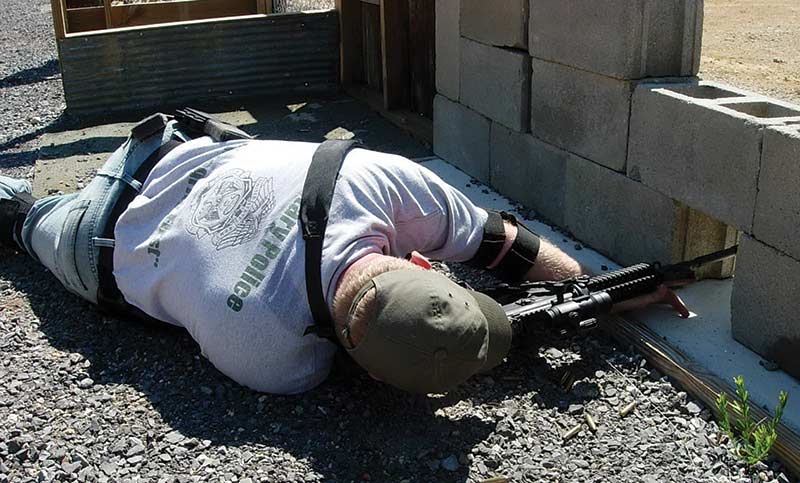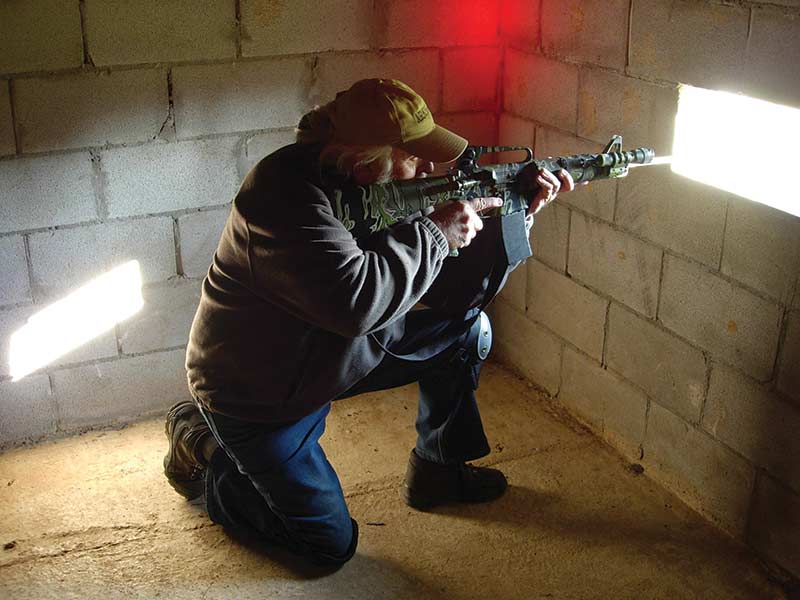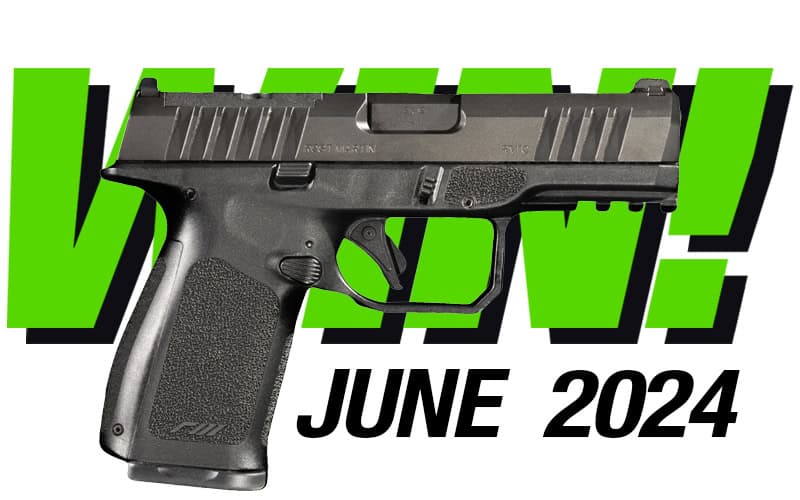Are You Covered?
You and your family are seated and enjoying a meal at the food court at the mall. The festive mood is shattered by the crack of gunshots. Two tables over you see a man with a pistol, and his wild eyes staring right at you. It’s 2:00 am and you’re walking up a sidewalk, responding to a domestic dispute call. A man steps out from a darkened corner of the porch. Instantly you realize he’s leveling a shotgun on you. You and your squad are patrolling a crowded market in Iraq. Little by little, you notice people leaving the area. The violent explosion of an I.E.D. knocks you to the ground, the eruption initiating a vicious firefight.
When it comes to fighting, no matter who you are, victory depends on movement, communication, shooting as necessary, and whenever possible, using cover. You move to get to an exit, create distance, and obtain a clear angle of fire or advantageous field position. You communicate by issuing verbal commands to the threats, telling your family or bystanders where to go, and to coordinate tactics with armed partners. You shoot to neutralize bad guys, force them to break off contact, or surrender. And whenever possible we use cover for the protection it offers, regardless of the weapon the attacker is armed with.
Cover creates a physical barrier between you, the threat, and their weapon. An attacker armed with a knife charges you. Putting something like a car between him and you reduces the effectiveness of his weapon. That’s a pretty simple concept to grasp. Using cover for protection against a threat armed with a firearm is a more subjective concept. For example, the degree of protection cover provides depends on what type of rounds are coming your way. An object that protects you from handgun rounds might not hold up well against high velocity rifle rounds. Even among rifle calibers there is a significant difference in penetration capabilities. A round of 5.56mm ball ammunition penetrates about 1.5 inches of concrete. A round of .30- 06 armor piercing ammunition can punch through five times that much. Most objects in our environments are probably better thought of as bullet resistant rather than bullet proof.
Regardless of the caliber, when those rounds hit a hardened surface there is a violent reaction. As rounds skip off surfaces, or pass through something like a car and exit out the other side, the bullet fragments and creates debris from the concrete, glass, plastic, and metal of those objects. Now instead of dealing with one bullet you’ve got 20 sharp projectiles flying at you. These flying fragments can injure and kill.
With this in mind, one of the first principles we want to apply for using cover is to create distance between our body and the objects we are using for protection. This reduces the danger of being injured by fragmentation and debris. Creating this distance is also a difficult thing to do. It goes completely against our natural instincts; instinctually, the closer we hug cover the safer we feel. This overpowering desire to crowd cover is an excellent example where our natural instincts are counter productive to fighting with firearms, and shows why repetitious training is necessary to overcome these dangerous instinctual actions.
Another advantage of having distance from cover is that it widens your field of view, allowing you to see more of the threat environment. Imagine you’re driving down the interstate with a semi-truck in front of you. If you get really close to the back of that truck all you can see is the truck’s rear end. From here, if something unexpected happens you won’t know about it until you smash into the truck. Now, back off the truck, creating some space. Your field of view opens up, allowing you to see what’s going on in the next lane and ahead of the truck on an uphill climb. The same thing applies to using cover. Jam your eyes up there real close and you can lose 50 percent or more of your visual field. If you can’t see what’s happening it makes it hard to react accordingly.
How much distance do we need between us and cover? To answer this question we look to geometry. The rules of geometry apply to a lot of aspects of fighting, and this is a prime example. When you are dealing with one opponent, backing away from cover puts more distance between you and the threat, usually a good thing, and creates a larger area of protection (Diagram 1). This provides more space for you to operate in — you can move laterally, forward or to the rear and still have cover — widens your field of view, and decreases the possibility of injury from debris and fragmentation created by incoming rounds. In this situation distance is our friend.
But, there are some situations where you can’t create that distance. If you are fighting more than one threat the geometry of the situation completely changes. The farther away you get from cover the less area of protection you have, and if you move too far back you’re exposed to multiple threats at the same time. In this situation you want to get as close as necessary to cover, keeping in mind the dangers of being too close. Or, if the threat is elevated, on higher ground, you have to get closer to cover because of the angles involved. You have to be able to “see” the geometry and determine where the best place to be positioned is according to the situation.
Once you’re behind cover you probably won’t be able to hunker down there until the fight is over. Fights are fluid and dynamic, most likely everyone will be moving. You can have a good position behind cover, and all the threat has to do is step right or left and your geometry completely changes. Either your whole body is now exposed to the threat, or you can’t see the bad guys and they are using “your” cover to advance or flank you. Remember Newton’s law: for every action there is an equal and opposite reaction. This applies to physics and fighting. As the threats move we initiate counter actions immediately, which means maintaining visual contact so we can react accordingly. Always keep in mind that cover is a two-sided coin. You may be facing someone who knows just as much as you do, or more, about fighting and using cover. Don’t underestimate the threat’s abilities, or overestimate your skills.
In addition to these issues there are other principles we need to apply to maximize the protection of cover. Whenever possible we want to remain standing. By staying on your feet you can move and reposition as the fight unfolds. The problem is that a lot of objects in our environments, especially urban areas, require us to lower our profile for protection. When a lower position is necessary we want to use positions that are quick to get into, and quick to get up and mobile as necessary. “Reactive positions,” such as variations of the kneeling positions, are quick to
assume and, equally important, quick to get up and out of. John Plaster, in Secret Commandos, stories of SOG operations in Vietnam, explains that such positions “made it physically — and especially, psychologically — easier to get up and go when it was time to move …”
“Premeditated positions,” like prone or sitting, are slower to get into and out of. This could be a problem under the dynamic conditions of fighting, so these positions are normally reserved for specific situations as opposed to general-purpose use. For example, rollover prone is used to shoot underneath an object such as a car. Just remember you can drop into prone pretty quick, especially when someone is shooting at you, but in most environments it will put you too low to see anything, it’s slow to get out of, and moving laterally or repositioning while prone is problematic. Every position has advantages and disadvantages. Your job is to train and practice enough to understand the application of these positions in relationship to the use of cover.
We can also use cover to create a more stable platform for accuracy. Precision shots require stability. We gain stability by lowering our center of gravity and/or creating more contact points between our body and something solid, bracing or resting on something like the ground, a wall or tree. Just be careful about sticking your muzzle past something if you don’t know what’s on the other side of it — you don’t want anyone grabbing your weapon and disarming you — and be sure not to put any body parts like hands and fingers where they could be injured by debris and fragmentation from incoming rounds. Also, keep in mind the geometric disadvantages we discussed of positioning yourself too close to cover. Again, the situation determines your best option.
During firefights the majority of lethal wounds occur from head injuries. To reduce this risk we work around the side of cover instead of over the top of it. Shooting over the top of an object exposes everything from the shoulders up, which of course includes your head. By working around the side of an object, using vertical angles, you expose less of your head to the threat as opposed to using horizontal angles, shooting over the top of something. When there is incoming fire, it’s a good idea to get everything behind cover.
The majority of violent confrontations occur in low-light environments, so your training and practice with cover should include low-light sessions to figure out how everything works when using an artificial light source. For example, when using a hand-held light and working around the right side of cover the light should be positioned on the right side of the weapon. On the left side of cover the light is transitioned to the left side of the weapon.
This positioning of the light provides maximum penetration of light into the threat area, and the least amount of light reflecting back off that surface, which illuminates you and affects your night vision. Distance from cover is also an issue, since the farther away you are the wider your light beam is. Aiming your light slightly left or right of cover will help with this. Although the cone of the beam won’t be exactly centered on the threat you’ll still have plenty of light to accomplish your task.

Cover is relative to what the bad guy is shooting at you with. In this
test the targets were set behind the blocks, with shots fired straight
on. The .45 chipped the block, but no fragments hit the target. The
.223 sprayed fragments to the left and right of the block, but only
penetrated through half the block. A 7.62x39 round destroyed the
block, and punched through the target.
Should a right-handed shooter, working around the left side of cover, swap the weapon over to the left hand to operate and fire? In my opinion this is not a good idea. It boils down to time, efficiency, and accuracy. There is time lost during the act of transitioning from one hand to another, and always the possibility of fumbling or dropping your weapon. Unless you are truly ambidextrous, physically and mentally capable of operating the weapon with either strong or weak hand, you won’t manipulate the weapon as efficiently using the weak hand. All of this is compounded if you are using a hand-held light. (Remember, even if you have a weapon mounted light, when it fails you’ll have to use your secondary light.)
As for accuracy, you probably won’t shoot as quickly or as accurately with your weak hand. In a hostage situation a half second delay or an inch off in bullet impact could be disastrous. With practice you should be able to modify your fighting positions so that you can work from either side of cover using your strong hand without exposing much of your body. Now, I’m not saying you shouldn’t practice using your weak hand. It’s always a good idea to be able to operate your weapons with either hand in case one hand or arm is wounded and out of commission.
What about concealment, which hides you from view but doesn’t offer you any protection? As Clint Smith says, “people shoot you because they see you. They see you because you let them. Don’t let them see you.” While concealment doesn’t protect you from incoming rounds, if the threat doesn’t know where you are, that reduces the possibility of them shooting at you. Then, when the time is right and you are ready, you can escape, get to a better location with cover, or engage the threat as necessary. If you do have cover then you should be looking for better cover, something more substantial or farther away from the threat, so at the first opportunity you’re up and moving. And remember, anything you can put between you and the threat is better than nothing. A sheetrock wall may not appear to offer much protection, but one thing about small arms fire is that once those rounds strike an object it’s hard to predict how they will react. Who knows, the round might hit a stud in the wall and veer off path, missing you completely.
The key to using cover is to remember that the situation and environment dictate your options. A fight that starts without warning with a threat at arms length might not initially contain time for you to use cover. However, since we can’t predict what it will take to end the fight, or how long it will last, at the first opportunity you should create distance and get to cover. By being aware of your environment and cueing in suspicious actions you may make it to cover prior to the fight starting. So, while watching the people around you and what they are doing, start making it a habit of studying the objects in that environment. Ask yourself, “if trouble developed what would work as cover?” Then, if something does happen, you already know where you are going.
Properly exploiting cover, like all aspects of personal combat, requires plenty of practice to become proficient. Before you start crying about not having time to go to the range, or that your range doesn’t allow you to practice “tactics,” keep in mind that learning to work cover can be done almost anywhere. You can use a dummy weapon, or just pretend you’ve got your rifle or pistol, and practice at home using furniture or wall corners as representations of cover. With airsoft weapons you can practice tactics in your backyard or basement. (Just remember these weapons fire projectiles capable of injuring someone, so keep it safe.)
People come up with a lot of reasons why they don’t practice. I have one really good reason why you should: we are talking about skills that save lives. If you’ve already experienced the chaos of violence then you know how important it is to be ready. If you’ve never been involved in a violent confrontation, chances are you’ve probably got one coming sometime in your future. Relying on skill is always better than just hoping you’ll get lucky. So take the time, and make sure that when your turn does come, you’re prepared.

Sign up for the Personal Defense newsletter here:














